1.5 Cylindrical and Spherical Coordinates
52
A standard way to represent a point in the plane \({\mathbb R}^2\) is by means of rectangular coordinates \((x,y)\). However, as you have probably learned in elementary calculus, polar coordinates in the plane can be extremely useful. As portrayed in Figure 1.79, the coordinates \((r,\theta)\) are related to \((x,y)\) by the formulas \[ x = r \cos \theta \qquad \hbox{and} \qquad y = r \sin \theta, \] where we usually take \(r \ge 0\) and \(0 \le \theta < 2 \pi\).
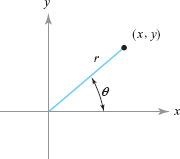
If you are not familiar with ploar coordinates, we advise you to study the relevant section of their calculus texts. We now set forth two ways of representing points in space other than by using rectangular Cartesian coordinates \((x,y,z)\). These alternative coordinate systems are particularly well suited for certain types of problems, such as the evaluation of integrals using a change of variables.
Historical Note
In 1671, Isaac Newton wrote a manuscript entitled The Method of Fuxions and Infinite Series, which contains many uses of coordinate geometry to sketch the solutions of equations. In particular, he introduces the polar coordinate system, among various other coordinate systems.
In 1691, Jacob Bernoulli published a paper also containing polar coordinates. Because Newton’s manuscript was not published until after his death in 1727, credit for the discovery of polar coordinates is usually attributed to Bernoulli.
Cylindrical Coordinates
Definition
The cylindrical coordinates \((r,\theta,z)\) of a point \((x,y,z)\) are defined by (see Figure 1.80) \begin{equation} x = r \cos \theta, y = r \sin \theta, z=z. \end{equation}
53
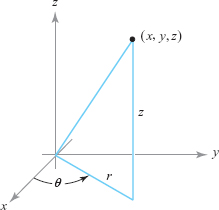

To express \(r,\theta\), and \(z\) in terms of \(x,y\), and \(z\), and to ensure that \(\theta\) lies between \(0\) and \(2\pi\), we can write \[ r=\textstyle\sqrt{x^2+y^2\ }, \hskip17.8pt \theta=\left\{ \begin{array}{@{}l@{\qquad}l@{\qquad}l@{}} \tan^{-1}(\kern1pty/x) & \hbox{if } x>0 \hbox{ and } y\geq 0\\[2pt] \pi + \tan^{-1}(\kern1pty/x)& \hbox{if } x < 0\\[2pt] 2\pi+\tan^{-1}(\kern1pty/x) & \hbox{if }x> 0 \hbox{ and }y<0, \end{array} \right. \hskip-4ptz=z, \] where \(\tan^{-1}(\hskip1pty/x)\) is taken to lie between \(-\pi/2\) and \(\pi/2\). The requirement that \(0 \le \theta < 2\pi\) uniquely determines \(\theta\) and \(r \ge 0\) for a given \(x\) and \(y\). If \(x=0\), then \(\theta=\pi/2\) for \(y>0\) and \(3\pi /2\) for \(y<0\). If \(x=y=0,\theta\) is undefined.
In other words, for any point \((x,y,z)\), we represent the first and second coordinates in terms of polar coordinates and leave the third coordinate unchanged. Formula (1) shows that, given \((r, \theta,z)\), the triple \((x,y,z)\) is completely determined, and vice versa, if we restrict \(\theta\) to the interval \([0,2 \pi)\) (sometimes the range \(( - \pi , \pi]\) is convenient) and require that \(r > 0\).
To see why we use the term cylindrical coordinates, note that if the conditions \(0 \le \theta \,{<}\,2\pi, - \infty < z < \infty\) hold and if \(r=a\) is some positive constant, then the locus of these points is a cylinder of radius \(a\) (see Figure 1.81).
example 1
(a) Find and plot the cylindrical coordinates of (6, 6, 8). (b) If a point has cylindrical coordinates \((8,2 \pi/3, -3)\), what are its Cartesian coordinates\(?\) Plot.
solution For part (a), we have \(r = \sqrt{6^2 + 6^2} = 6 \sqrt{2}\) and \(\theta = \tan^{-1} (6/6)= \tan^{-1} (1) = \pi/4\). Thus, the cylindrical coordinates are \((6\sqrt{2}, \pi /4, 8)\). This is point P in Figure 1.82.
54
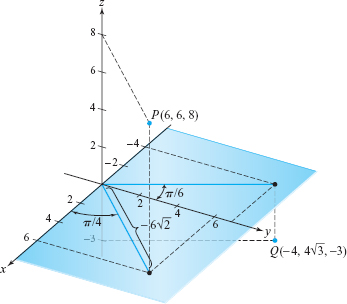
For part (b), note that \(2\pi/3 =\pi/2 + \pi/6\) and compute \[ x = r \cos \theta = 8 \cos \frac{2 \pi}{3} = - \frac{8}{2} =-4 \] and \[ y =r \sin \theta = 8 \sin \frac{2 \pi}{3} = 8 \frac{ \sqrt{3}}{2} = 4 \sqrt{3}. \]
Thus, the Cartesian coordinates are \((-4,4 \sqrt{3},-3)\). This is point Q in the figure.
Spherical Coordinates
Cylindrical coordinates are not the only possible generalization of polar coordinates to three dimensions. Recall that in two dimensions the magnitude of the vector \(x {\bf i}+ y {\bf j}\) \(\big(\)that is, \(\sqrt{x^2 + y^2}\big)\) is the \(r\) in the polar coordinate system. For cylindrical coordinates, the length of the vector \(x {\bf i} + y {\bf j} + z {\bf k}\), namely, \[ \rho=\textstyle \sqrt{x^2 + y^2 + z^2}, \] is not one of the coordinates of that system—instead, we used the magnitude \(r = \sqrt{x^2 + y^2}\), the angle \(\theta\), and the “height” \(z\).
We now modify this by introducing the spherical coordinate system, which does use \(\rho\) as a coordinate. Spherical coordinates are often useful for problems that possess spherical symmetry (symmetry about a point), whereas cylindrical coordinates can be applied when cylindrical symmetry (symmetry about a line) is involved.
55
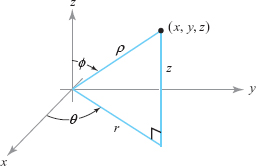
Given a point \((x,y,z) \in {\mathbb R}^3\), let \[ \rho = \textstyle\sqrt{x^2 + y^2 + z^2} \] and represent \(x\) and \(y\) by polar coordinates in the \(xy\) plane: \begin{equation} x = r \cos \theta, y= r \sin \theta,\tag{2} \end{equation} where \(r = \sqrt{x^2 + y^2}\) and \(\theta\) is determined by formula (1) [see the expression for \(\theta\) following formula (1)]. The coordinate \(z\) is given by \[ z = \rho \cos \phi, \]
where \(\phi\) is the angle (chosen to lie between 0 and \(\pi\), inclusive) that the radius vector \({\bf v} = x {\bf i} + y {\bf j} + z {\bf k}\) makes with the positive \(z\) axis, in the plane containing the vector \({\bf v}\) and the \(z\) axis (see Figure 1.83). Using the dot product, we can express \(\phi\) as follows: \[ \cos \phi = \frac{{\bf v \,{\cdot}\, k}}{\|{\bf v}\|}, \hbox{that is}, \phi = \cos^{-1} \!\bigg( \frac{{\bf v \,{\cdot}\, k}}{\|{\bf v}\|} \bigg). \]
We take as our coordinates the quantities \(\rho,\theta,\phi\). Because \[ r=\rho\sin \phi, \] we can use formula (2) to find \(x,y,z\) in terms of the spherical coordinates \(\rho,\theta,\phi\).
Definition
The spherical coordinates of points \((x, y, z)\) in space are the triples \((\rho, \theta, \phi)\), defined as follows: \begin{equation} x=\rho\sin \phi \cos \theta, y=\rho\sin\phi\sin\theta, z=\rho\cos \phi,\tag{3} \end{equation} where \[ \rho\geq 0, 0\,\leq\, \theta\,<\,2\pi, 0\leq \phi\leq \pi. \]
56
Historical Note
In 1773, Joseph Louis Lagrange was working on Newton’s gravitational theory as it applied to ellipsoids of revolution. In attempting to calculate the total gravitational attraction of such an ellipsoid, he encountered an integral that was difficult to evaluate. Motivated by this application, he introduced spherical coordinates, which allowed him to calculate the integral. We will be discussing the method of changing coordinates as it applies to multiple integrals in Section 6.2, and applications to gravitation in Section 6.3, where we show how the inverse square law of gravity allowed Newton to consider spherical masses as point masses.
Spherical coordinates are also closely connected to navigation by latitude and longitude. To see the connection, first note that the sphere of radius \(a\) centered at the origin is described by a very simple equation in spherical coordinates, namely, \(\rho = a\;\). Fixing the radius \(a\), the spherical coordinates \(\theta \) and \(\phi \) are similar to the geographic coordinates of longitude and latitude if we take the earth’s axis to be the \(z\) axis. There are differences, though: The geographical longitude is \(\vert \theta \vert \) and is called east or west longitude, according to whether \(\theta \) is a positive or negative measure from the Greenwich meridian; the geographical latitude is \(\vert \pi/2\,{-}\, \phi \vert\) and is called north or south latitude, according to whether \(\pi/2\,{-}\,\phi\) is positive or negative.
example 2
- (a) Find the spherical coordinates of the Cartesian point \((1,-1,1)\) and plot.
- (b) Find the Cartesian coordinates of the spherical coordinate point \((3, \pi /6, \pi /4)\) and plot.
- (c) Let a point have Cartesian coordinates \((2,-3, 6)\). Find its spherical coordinates and plot.
- (d) Let a point have spherical coordinates \((1, -\pi /2, \pi /4)\). Find its Cartesian coordinates and plot.
solution
- (a) \(\rho = \sqrt{x^2 + y^2 + z^2} = \sqrt{1^2 + (-1)^2 + 1^2} = \sqrt{3}\),
- \(\theta = 2\pi +\tan^{-1} \!\left( \displaystyle\frac{y}{x} \right) = 2\pi +\tan^{-1}\! \left( \displaystyle\frac{-1}{1} \right) = 2\pi- \displaystyle\frac{\pi}{4}=\frac{7\pi}{4}\)
- \(\phi= \cos^{-1} \!\left( \displaystyle\frac{z}{\rho} \right) = \cos^{-1}\! \left( \displaystyle\frac{1}{\sqrt{3}} \right) \approx 0.955 \approx 54.74^\circ.\)
- (b) \(x = \rho \sin \phi \cos \theta = 3 \sin \!\left( \displaystyle\frac{\pi}{4} \right) \cos \!\left(\displaystyle \frac{\pi}{6} \right) =3\! \left(\displaystyle \frac{1}{\sqrt{2}} \right) \displaystyle\frac{\sqrt{3}}{2} = \displaystyle\frac{3 \sqrt{3}}{2 \sqrt{2}}\),
- \(y = \rho \sin \phi \sin \theta = 3 \sin \! \Big(\displaystyle\frac{\pi}{4}\Big) \sin \!\left(\displaystyle\frac{\pi}{6}\right) = 3\! \left(\frac{1}{\sqrt{2}}\right)\! \left(\displaystyle\frac{1}{2} \right) = \displaystyle \frac{3}{2 \sqrt{2}}\),
- \(z= \rho \cos \phi = 3 \cos\! \Big(\displaystyle\frac{\pi}{4}\Big) = \displaystyle\frac{3}{\sqrt{2}} = \displaystyle\frac{3\sqrt{2}}{2} .\)
See Figure 1.84.
57
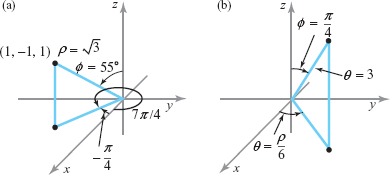 Figure 1.84: Finding (a) the spherical coordinates of the point (1, –1, 1), and (b) the Cartesian coordinates of (3, \(\pi/6\), \(\pi/4\)).
Figure 1.84: Finding (a) the spherical coordinates of the point (1, –1, 1), and (b) the Cartesian coordinates of (3, \(\pi/6\), \(\pi/4\)). - (c) \(\rho = \sqrt{ x^2 + y^2 + z^2} = \sqrt{ 2^2 + (-3)^2 + 6^2} = \sqrt{49} = 7\),
- \(\theta = 2\pi+\tan^{-1} \!\left(\displaystyle\frac{y}{x}\right) =2\pi+ \tan^{-1} \! \left(\displaystyle\frac{-3}{2}\right) \approx 5.3004 \hbox{ radians} \approx 303.69^\circ,\)
- \(\phi = \cos^{-1} \! \left(\displaystyle\frac{z}{\rho} \right) = \cos^{-1}\! \left(\displaystyle\frac{6}{7} \right) \approx 0.541 \approx 31.0^\circ.\)
- (d) \(x= \rho \sin \phi \cos \theta = 1 \sin\! \left(\displaystyle\frac{\pi}{4} \right) \cos \! \left(\displaystyle -\frac{\pi}{2} \right) = \bigg(\displaystyle\frac{\sqrt{2}}{2} \bigg) \,{\cdot} \ 0 =0,\)
- \(y = \rho \sin \phi \sin \theta = 1 \sin \! \left(\displaystyle\frac{\pi}{4} \right) \sin \!\left(\displaystyle -\frac{ \pi}{2} \right)= \bigg(\displaystyle\frac{\sqrt{2}}{2} \bigg) (-1) = -\frac{\sqrt{2}}{2}\),
- \(z = \rho \cos \phi = 1\cos \! \Big(\displaystyle\frac{\pi}{4} \Big) = \displaystyle\frac{\sqrt{2}}{2}.\)
 Figure 1.85: Finding (a) the spherical coordinates of the point (2, \(-3\), 6), and (b) the Cartesian coordinates of (1, \(-\pi/2\), \(\pi/4\)).
Figure 1.85: Finding (a) the spherical coordinates of the point (2, \(-3\), 6), and (b) the Cartesian coordinates of (1, \(-\pi/2\), \(\pi/4\)).
58
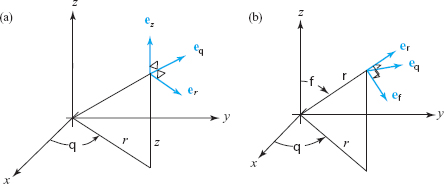
example 3
Express (a) the surface \(xz=1\) and (b) the surface \(x^2 + y^2 - z^2 \,{=}\,1\) in spherical coordinates.
solution From formula (3), \(x = \rho \sin \phi \cos \theta, \hbox{and } z = \rho \cos \phi\), and so the surface \(xz = 1\) in (a) consists of all \((\rho, \theta, \phi)\) such that \[ \rho^2 \sin \phi \cos \theta \cos \phi =1, \qquad\hskip-2.5pt \hbox{that is,} \qquad \rho^2 \sin 2 \phi \cos \theta =2. \]
For part (b), we can write \[ x^2 + y^2 - z^2 = x^2 + y^2 + z^2 - 2 z^2 = \rho^2- 2 \rho^2 \cos^2 \phi, \] so that the surface is \(\rho^2 (1-2 \cos^2 \phi) =1;\) that is, \(- \rho^2 \cos\, ( 2 \phi) =1\).
Associated with cylindrical and spherical coordinates are unit vectors that are the counterparts of \({\bf i},{\bf j}\), and \({\bf k}\) for rectangular coordinates. They are shown in Figure 1.86. For example, \({\bf e}_r\) is the unit vector parallel to the \(xy\) plane and in the radial direction, so that \({\bf e}_r =(\cos \theta){\bf i}+(\sin \theta){\bf j}\). Similarly, in spherical coordinates, \({\bf e}_\phi\) is the unit vector tangent to the curve parametrized by the variable \(\phi\) with the variables \(\rho\) and \(\theta\) held fixed. We shall use these unit vectors later when we use cylindrical and spherical coordinates in vector calculations.